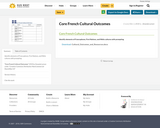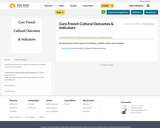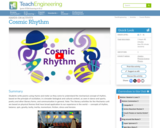
Identify elements of Francophone, First Nations, and Métis cultures with prompting.
- Subject:
- French
- Language Education
- Material Type:
- Activity/Lab
- Date Added:
- 10/01/2018

Identify elements of Francophone, First Nations, and Métis cultures with prompting.

Identify elements of Francophone, First Nations, and Métis cultures with prompting

This site incorporates learning activities for Core French from grades 5-7.
Included on the site are themes for the classroom, art, card and board games, movement games, and a word reference French dictionary.

Ms. Campbell's original and curated resources for Core French instruction (worksheets, instructions, samples, videos, slideshows, etc.), organised by unit. Instructions are in English.

Students will sequence photographs to tell the story of Seed to Cereal, while learning about corn production, beef production, ethanol production, and food production in general.

Students will compare and contrast corn and soybean plants, the growth and development, and how each are used for different purposes and make different products that all of us use daily. Students will also learn and identify the parts of a monocot and dicot and measure growth.

Students will work to solve math problems relating to volume, while learning about corn production in Iowa.

In this activity, students examine how to grow plants the most efficiently. They imagine that they are designing a biofuels production facility and need to know how to efficiently grow plants to use in this facility. As a means of solving this design problem, they plan a scientific experiment in which they investigate how a given variable (of their choice) affects plant growth. They then make predictions about the outcomes and record their observations after two weeks regarding the condition of the plants' stem, leaves and roots. They use these observations to guide their solution to the engineering design problem. The biological processes of photosynthesis and transpiration are briefly explained to help students make informed decisions about planning and interpreting their investigation and its results.

This art history video discussion examines the "Coronation Mantle" likely made for the Norman ruler Roger II in 1133/34 in the royal workshop in Palermo of fabric from Byzantium or Thebes, Samite, silk, gold, pearls, filigree, sapphires, garnets, glass, and cloisonne enamel.

This art history video discussion examines Correggio's "Jupiter and Io" 1532-33, oil on canvas 163.5 x 70.5 cm (Kunsthistorisches Museum, Vienna).

Today we’re going to talk about data relationships and what we can learn from them. We’ll focus on correlation, which is a measure of how two variables move together, and we’ll also introduce some useful statistical terms you’ve probably heard of like regression coefficient, correlation coefficient (r), and r^2. But first, we’ll need to introduce a useful way to represent bivariate continuous data - the scatter plot. The scatter plot has been called “the most useful invention in the history of statistical graphics” but that doesn’t necessarily mean it can tell us everything. Just because two data sets move together doesn’t necessarily mean one CAUSES the other. This gives us one of the most important tenets of statistics: correlation does not imply causation.

There are a series of videos for movement, brain breaks, yoga, and energizing breaks with younger kids!
There are videos for:
Movement & Yoga
Mindfulness
Relaxation
Energy
Brain Breaks
Dancing

Students will eat up this lesson about oranges as they practice the skills that help them investigate and make detailed observations for descriptive purposes.

In this lesson, students will explain CRaTER's purpose and how it works. They will also design (using paper and pencil) a cosmic ray detector to answer their own questions. CRaTER's purpose is to identify safe landing sites for future human missions to the moon; discover potential resources on the Moon; and characterize the radiation environment of the Moon. The lesson includes background information for the teacher, questions, and information about student preconceptions. This is lesson 4 of 4 from "The Cosmic Ray Telescope for the Effects of Radiation."

Students write poems using rhyme and meter as they come to understand the mechanical concept of rhythm, based on the principle of oscillation, in a broader biological and cultural context, as seen in dance and sports, poetry and other literary forms, and communication in general. Note: The literacy activities for the Mechanics unit are based on physical themes that have broad application to our experience in the world â concepts of rhythm, balance, spin, gravity, levity, inertia, momentum, friction, stress and tension.

This 9-minute video lesson considers various theories about the size of the universe. [Cosmology and Astronomy playlist: Lesson 19 of 85]

This 7-minute video lesson looks at apsidal precession (Perihelion Precession) and Milankovitch Cycles. [Cosmology and Astronomy playlist: Lesson 75 of 85]

This 7-minute video lesson addresses the question: Are southern hemisphere seasons more severe because of the eccentricity in Earth's orbit? [Cosmology and Astronomy playlist: Lesson 72 of 85]

This 11-minute video lesson looks at the process of a star becoming a red giant. [Cosmology and Astronomy playlist: Lesson 17 of 85]

This 10-minute video lesson looks at the beginnings of life on Earth. Life and photosynthesis start to thrive in the Archean Eon. [Cosmology and Astronomy playlist: Lesson 39 of 85]